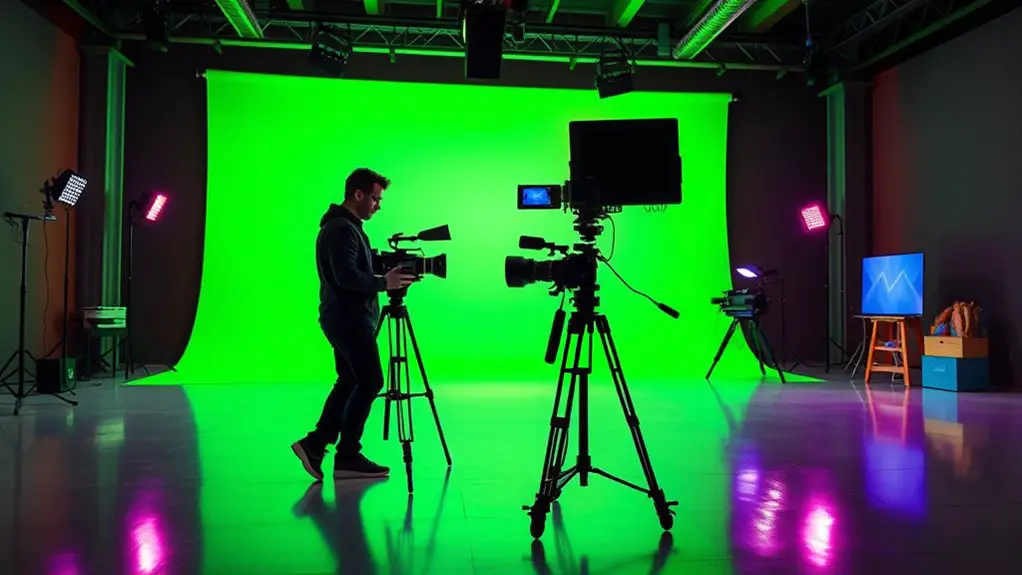Chroma key, commonly called green screen, is a powerful video editing technique that lets you replace a solid-colored background—typically green or blue—with any scene or image. This technology relies on color separation principles and requires careful lighting to avoid shadows that can complicate editing. By keeping subjects away from the backdrop, you minimize color spill and create a natural look. If you want to enhance your skills further, there's more to explore about effective techniques and common pitfalls.
Understanding Chroma Key Technology
Chroma key technology, often referred to as green screen, is a powerful tool in video editing that allows you to replace a specific color background with another image or video. To master the chroma keying basics, you'll first need to understand the significance of color selection techniques. Choosing the right shade—typically green or blue—ensures a clean key. Make sure your subject doesn't wear colors that match the background, or you'll risk disappearing into the scene! Lighting plays an essential role as well; even illumination helps avoid shadows, which can complicate the editing process. With practice, you can creatively transport your subjects anywhere, from vibrant landscapes to futuristic cities, revealing a world of visual possibilities that can truly set your work apart.
The Science Behind Green Screens
The effectiveness of green screens hinges on the principles of color separation and light absorption. By utilizing specific wavelengths of green, filmmakers exploit our color perception to create a seamless background replacement. The bright green hue is chosen because it contrasts well with most skin tones, minimizing interference during the editing process. Proper lighting techniques are essential here; even illumination across the screen guarantees that shadows don't distort the color, making it easier for software to recognize and replace the background. When you light your green screen evenly, you enhance the chroma key process, allowing for a more professional-looking final product. Embracing these scientific principles gives you the creative freedom to transport your audience anywhere in mere moments.
Applications of Chroma Key in Various Industries
While you might associate chroma key primarily with film and television, its applications extend far beyond the entertainment industry. In film production, it creates dynamic backdrops, transporting audiences to fantastical worlds. For virtual events, it facilitates immersive experiences, enhancing engagement and interaction. In video games, chroma keying integrates live-action elements, making gameplay more enthralling. News broadcasting utilizes it for seamless shifts and informative graphics, keeping viewers informed with style. Educational content also benefits, as educators can present engaging visuals that clarify complex topics. Additionally, marketing campaigns leverage chroma key to produce eye-catching advertisements, blending products with stunning visuals that capture attention. In each case, chroma key opens up creative possibilities, allowing you to express ideas without limits.
Tips for Effective Chroma Keying
To achieve seamless results in chroma keying, it's crucial to start with a well-lit background and subject. Utilize effective lighting techniques to eliminate shadows and create an even illumination on the green screen. Make sure your subject stands at least a few feet away from the backdrop to avoid color spill, which can complicate the keying process. Focus on color matching between your subject and the background; the green screen should complement the overall color palette of your final scene. When filming, consider using a high-quality camera and recording in a controlled environment to capture the best footage. Finally, during editing, experiment with settings to fine-tune your key, guaranteeing a polished and professional look.
Common Mistakes to Avoid in Chroma Key Editing
When diving into chroma key editing, overlooking fundamental principles can lead to frustrating results. One common mistake is neglecting lighting issues; uneven lighting can create harsh shadows or bright spots, making your keying difficult. Always aim for soft, diffused light to guarantee a consistent backdrop.
Another pitfall is failing to manage color spill—when the green hues reflect onto your subject, it can create an unnatural look. To combat this, position your subject further away from the screen and use backlighting to mitigate spill. Ultimately, don't rush the editing process. Take the time to fine-tune your settings, assuring a seamless composite. By avoiding these mistakes, you'll reveal the true potential of your creative vision.
Frequently Asked Questions
Can I Use Colors Other Than Green for Chroma Keying?
Absolutely, you can use blue screens for chroma keying! Just keep color considerations in mind, ensuring your subject doesn't wear the same color as the backdrop. This way, you'll achieve a seamless blend in your editing.
What Software Supports Chroma Keying Features?
When exploring software comparisons, you'll find many options supporting chroma keying techniques. Popular choices include Adobe Premiere Pro, Final Cut Pro, and DaVinci Resolve, each offering unique features to enhance your editing freedom and creativity.
Do I Need Professional Lighting for Green Screen Setups?
You don't necessarily need professional lighting, but using proper lighting techniques and balancing color temperature can greatly enhance your green screen results. Natural light or soft diffused lights can also achieve great effects without breaking the bank.
How Can I Remove Shadows From the Green Screen?
To remove shadows from your green screen, focus on shadow reduction through strategic lighting techniques. Use soft, diffused lights to minimize harsh shadows, ensuring even illumination across the backdrop for a seamless editing experience.
Is Chroma Keying Effective for Live Broadcasts?
Chroma keying's like magic for live streaming; it transforms your broadcast quality instantly! When done right, it eliminates distractions, immersing viewers in your content while giving you the freedom to create stunning, immersive experiences.

